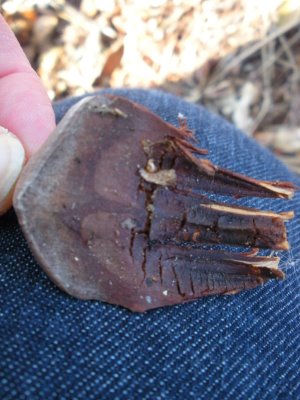Today ended up with a nature study of squirrels at my dad’s house. We had gone over to visit him this afternoon and somehow it was mentioned that we were studying squirrels this week. His eyes lit up and he took us out for a little walk on the backside of his property. He has been up there cutting wood and he had something to share with us.
This is what he wanted us to see up on the hill next to his woodpile. There was a whole area that was piled high with shredded pinecones. All of the reddish material that you see in this photo is the remnants of a squirrel feast. The squirrels have been very busy eating up in the trees and letting the litter fall to the ground in great heaps.
Here in the center, probably easier to see if you click the photo, are some of the many, many pinecones stripped of their tasty seeds.

Here one of the seeds from the cone after the squirrel has finished with it.
Now for a few more mammal signs from our walk.

We also saw these “signs” from some mule deer that live in this area. Just last week we saw seven deer walking down to my dad’s pond late in the afternoon. They seemed not to care that we were watching in awe of their beauty.

Then right down the hill from where we were, we saw these tell-tale signs of a busy gopher. You could not walk easily on this slope because the ground was just full of holes and tunnels.

Here is another view of one of the holes. My dad was thinking about making a new garden in this area but I told him he better think twice….deer and gophers don’t mix very well with a vegetable garden. Even though it is a perfect spot for growing with lots of sunlight, he would need to fence it like his other garden area….a very tall fence.
What a great way to study squirrels. My dad thinks of his property as a sort of nature study laboratory for our family. He will call us over if he sees something interesting and I love that about him. My dad and I did not spend much time together when I was a child because he was always working but now that he is retired, he and I share our love of all things that have to do with the great outdoors. He has not always been a fan of homeschooling but I think he now has changed his mind and is eager to help us out with our nature study.



































